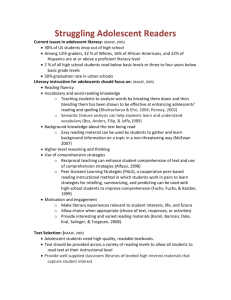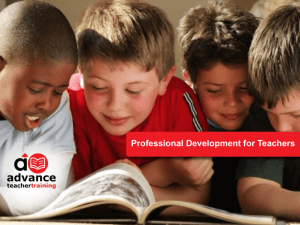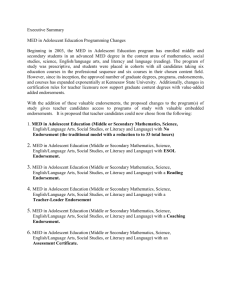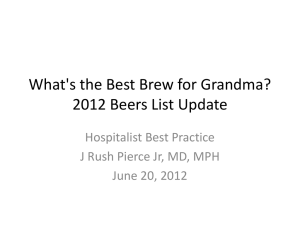When My Students Can`t Read, What Should I Do?
advertisement
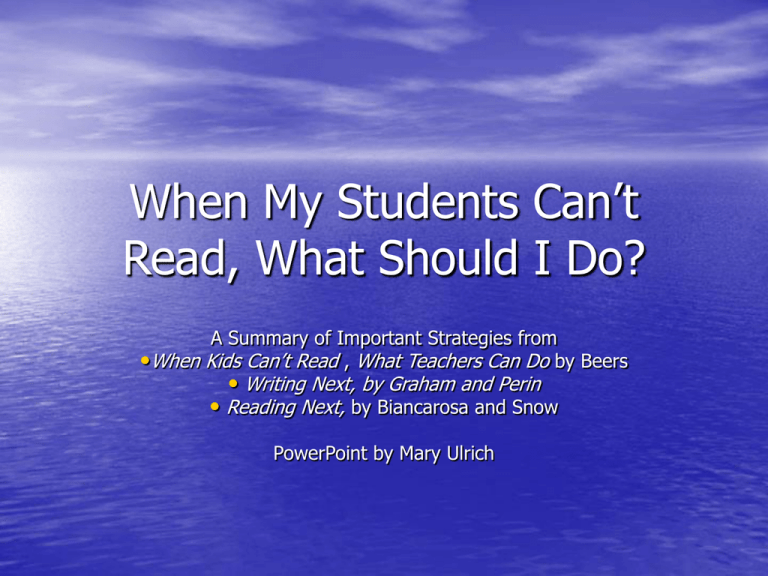
When My Students Can’t Read, What Should I Do? A Summary of Important Strategies from •When Kids Can’t Read , What Teachers Can Do by Beers • Writing Next, by Graham and Perin • Reading Next, by Biancarosa and Snow PowerPoint by Mary Ulrich Part I and Part II • Part I: Reading Strategies to Improve Adolescent Literacy • Part II: Writing Strategies to Improve Adolescent Writing Part I Reading Strategies to Improve Adolescent Literacy The Optimal Mix • Medical personnel need to tailor treatment to an individual patient’s needs. Sometimes, more than one type of treatment is necessary. • To continue the metaphor, teachers need to tailor intervention strategies to an individual student’s needs. Often, more than one strategy is needed. Fifteen Key Elements to Improve Adolescent Literacy Achievement • INSTRUCTINOAL IMPROVEMENTS -Direct, explicit comprehension instruction -Effective instructional principles embedded in content -Motivation and self-directed learning -Text-based collaborative learning -Strategic Tutoring -Diverse texts -Intensive writing -A technology component -Ongoing formative assessment of students • INFRASTRUCTURE IMPROVEMENTS -Extended time for literacy -Professional development -Ongoing summative assessment of students and programs -Teacher teams -Leadership -A comprehensive and coordinated literacy program Connecting When Kids Can’t Read, What Teachers Should Do to Reading Next • USING Kylene Beers’ Reading Strategies from When Kids Can’t Read, What Teachers Can Do 1. Assess dependent readers’ needs – see pages 24-26 in Beers’ book listed above 2. Create an instructional plan of what you will do when your student can’t… - see page 28 Connecting When Kids Can’t Read, What Teachers Should Do to Reading Next (continued) 3. Learn what skillful readers do – see pages 34-35 – know purpose for reading, use a variety of comprehension strategies, make a range of inferences, use their prior knowledge, monitor their understanding, question the author’s purpose and point of view, are aware of text features, evaluate their engagement and enjoyment with a text, know the meaning of many words, recognize most words automatically, read fluently, vary reading rate, and “hear” the text ads they read. 4. Teach comprehension strategies explicitly and directly – clarifying, comparing and contrasting, connecting to prior experiences, inferencing, predicting, questioning the text, recognizing the author’s purpose, seeing causal relationships, summarizing, visualizing. Teach explicitly and directly by “thinking aloud” as you model a strategy. INFERENCES Types of Inferences Skilled Readers Make • • • • • • • • • • • • • Recognize the antecedents for pronouns Figure out the meaning of unknown words from context Figure out the grammatical function of an unknown word Understand intonation of characters’ words Identify characters’ beliefs, personalities, and motivations Understand characters’ relationships to one another Provide details about the setting Provide explanations for events or ideas that are presented in the text Offer details for events or ideas that are presented in the text Understand author’s view of the world Recognize the author’s biases Relate what is happening in the text to their own knowledge of the world Offer conclusions from facts presented in the text See page 64 in Beers for comments teachers can make to help students make inferences A Strategy: Making Inferences • Use “It Says-I Say-And So” (p 165, Beers) to make inferences from Two Minute Mysteries Some thoughts to think about: • Best instructional improvements are informed by • • ongoing assessments of the strengths and needs of the students. However, these types of assessments, often informal and occurring on a daily basis, are not often suited to the way we must report progress, as in letter grades and percentages. Teacher teams need to establish coordinated instruction in reading during collaborative meetings to make sure that students don’t slip through the cracks. Outcomes to Measure • • • • • • • • • • Word-level reading Fluency Reading level Reading comprehension Writing Motivation Content achievement State assessments Student response Fidelity of model adoption/implementation Optimal Mix • Research and professional opinion support all fifteen elements from Reading Next; however, the optimal mix of these elements has not • • • • • been determined. Three elements are more foundational than the others: PROFESSIONAL DEVELOPMENT ONGOING FORMATIVE ASSESSMENT OF STUDENTS, AND ONGOING SUMMATIVE ASSESSMENT OF STUDENTS AND PROGRAMS These elements are not all inclusive due to the complex nature of improving adolescent reading, but are the required foundation on which the other elements should be built. Reading Literacy Conclusion • With carefully selected programs that allow teachers to use unique mixes of the fifteen elements and a requirement to use common evaluation guidelines and procedures, we, the teachers, can enhance adolescent literacy achievement right now. Let’s do it! Part II • Writing Strategies to Improve Adolescent Writing Eleven Elements to Improve Writing Achievement • • • • • • • • • • • Writing Strategies Summarization Collaborative Writing Specific Product Goals Word Processing Sentence Combining Prewriting Inquiry Activities Process Writing Approach Study of Models Writing for Content Leanring Some Thoughts About the Eleven Elements: • In a the best world, teachers would incorporate all eleven elements into their everyday writing program. • Reality says that’s not possible, so another approach is to use the elements to build a unique writing program to support individual students’ needs. This will likely produce the biggest return. The Optimal Mix? • Researchers do not know what combination is • best or how much of each element to use which will maximize writing instruction for low achieving writers in particular. Nor do they know which combination of elements works best for which types of writers. The eleven elements are part of a literature review which aims to provide specific practices that have shown to be effective across a number of contexts. An Example of the Writing Strategies Element • Writing Strategies: An example is self-regulated strategy development (SRSD) – used to help students learn specific strategies for planning, drafting, and revising text. There are six stages: 1. Develop background knowledge 2. Describe the strategy 3. Model it – teacher shoe s how to use the strategy 4. Memorize it - the student memorizes the steps of the strategy, possible through a mnemonic 5. Support it – teacher supports/scaffolds student mastery of the strategy 6. Independent Use – students use strategy with less support To Get to the Independent Use Stage: • Teach students self regulation skills (goal setting, selfmonitoring, self-instruction, self-reinforcement). They help students to manage writing strategies, the writing process, and their behavior. • TWO MNEMONICS for students are: 1. PLAN (Pay attention to the prompt, Listen to the main idea, Add supporting details, Number your ideas) 2. WRITE – (Work from your plan to develop your thesis statement, Include transition words for each paragraph, Try to use different kinds of sentences, and Exciting, interesting, $10,000 words) An Example of the Collaborative Writing Element: • This is peer writing as a team. A higher achieving student is assigned to be the Helper (tutor) and a lower achieving student is assigned to be the Writer (tutee). The teacher’s job is to monitor, prompt, praise, and address concerns. An Example of Setting Specific Product Goals Strategy: • This method provides students with objectives to • focus on specific aspects of their writing. An example might be a position paper in which a student write a persuasive letter designed to get the audience to agree with him/her. In addition to the main goal, a teacher provides sub-goals – include a statement of belief, provide examples or supporting information. An Example of the Sentence Combining Element: • This strategy helps students to create more complex and sophisticated sentences through activities in which students combine sentences. • Some specific goals: Combine a high writer with a low writer and have them produce the following: 1. Combine smaller sentences into a compound sentence using and, but, and because 2. Embed and adjective or adverb from one sentence into another 3. Us adverbial or adjectival clauses from one sentence into another 4. Make multiple embeddings involving adjectives, adverbs, adverbial clauses, and adjectival clauses. An Example of Inquiry Activity Element: • Students examine an object and write about it. – Think of a seashell. Students examine a seashell by looking at it, touching it with their eyes closed, listening to it, etc. Students list details, becoming more and more precise and fine-tuning their descriptions, comparing the object to others, eliciting similes and metaphors. An Examples of the Study of Models Element: • Present students with models of excellent writing and examine them. The models may be written from opposing viewpoints. Using those models the teacher gives the students a writing assignment the next day in which they take an opposing viewpoint from another classmate. An Example of the Writing to Learn Element: • This element includes the element of summarization and is effective in content area classes. An example is to have students write about the parts of a flower and their purposes. Students come to a deeper understanding of the subject. Learning to Write and Writing to Learn • Learning to write is a skill that draws on sub-skills and processes: handwriting, spelling, vocabulary, punctuation, capitalizations, word usage, grammar, use of writing strategies. • Writing to learn is a tool for learning subject matter. It deepens and extends students’ knowledge. Learning to write leads to writing to learn which leads to, at the most advanced stage, using writing as a personal tool for transforming one’s own experiences and knowledge. THE GOAL IN WRITING IS KNOWLEDGE TRANFORMATION Here’s Your Challenge! • The large number of students who struggle with reading • • and writing literacy has not changed noticeably in decades. What has changed is our society, which is now driven by ever-increasing knowledge and ever-accelerating demands for reading and writing skills. The disparity between modern life demands and inadequate literacy achievement in eight million struggling readers and writers demands that we help these students by reforming our strategies and techniques for improving reading and writing literacy.
